Full Text Searchable PDF User Manual

GPS Page 1 of 17 S82V
Contents
Contents
Contents...........................................................................................................................................................................1
Chapter I : A brief introduction of S82V ...............................................................................................................2
Chapter II : S82V receiver main unit .....................................................................................................................3
Chapter
Ⅲ
: S82V accessories............................................................................................................................... 10
Appendix 1: Frequently Asked Questions.......................................................................................................... 17

GPS Page 2 of 17 S82V
Chapter I: A brief introduction of S82V
Chapter I : A brief introduction of S82V
The SOUTH S82V is a RTK GNSS receiver, built for precision, reliability and user friendliness.
S82V is able to receive GPS signals, and also satellite signals from GLONASS and GALILEO.
The S82V main receiver unit is integrated with GNSS antenna interface, GNSS module,
Bluetooth device to facilitate working convenience for the user.
The S82V receiver is lightweight and sturdy, and designed for rugged usage. The receiver
housing is waterproof and dustproof, and built with superior material to withstand long lasting
operation in the field.
The embedded receiver firmware can customize different RTK software for different
applications. The data transfer process is a very convenient one.
This device complies with Part 15 of the FCC Rules. Operation is subject to the following
two conditions: (1) this device may not cause harmful interference, and (2) this device must
accept any interference received, including interference that may cause undesired operation.
CAUTION:
a) The disposal of electric and electronic device as solid urban waste is strictly prohibited:
they must be collected separately.
b) Contact Local Authorities to obtain practical information about correct handling of the waste,
location and times of waste collection centres. When you buy a new device of ours, you can
give back to our dealer a used similar device.
c) The dumping of these devices at unequipped or unauthorized places may have hazardous
effects on health and environment.
d) The crossed dustbin symbol means that the device must be taken to authorized collection
centres and must be handled separately from solid urban waste.
NOTES:
The treatment, recycling, collection and disposal of electric and electronic devices may vary in
accordance with the laws in force in the Country in question.
You could contact
export@southsurvey.com
for any enquiries pertaining to the S82V.
2
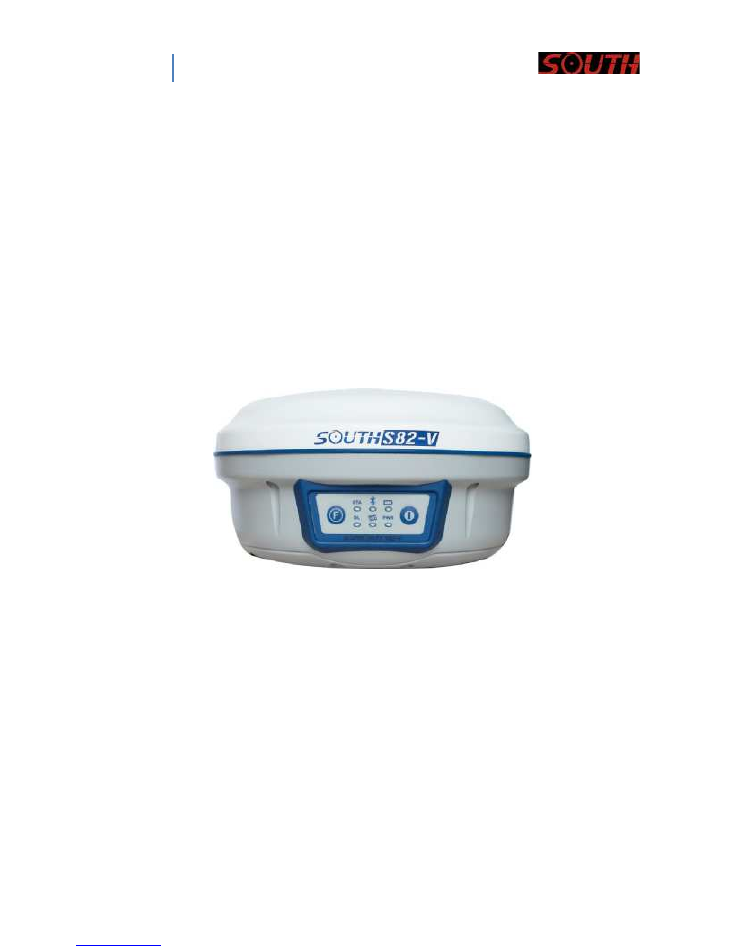
GPS Page 3 of 17 S82V
Chapter II: S82V receiver main unit
Chapter II : S82V receiver main unit
II.1 The receiver main body
There are three parts to the main unit: the cover, a protective rubber ring and
the main
structure. The cover protects the GNSS antenna inside. The protective rubber ring
has the function of additional protection against water and dust. The display LED panel
and control keys are integrated into front of the main structure. On the bottom there is a slot
for the built-in a compartment for the batteries. All the others components of the
receiver (Bluetooth device, main board, etc.) are contained inside the main structure of
the receiver.
Fig. 2.1
–
S82V main unit
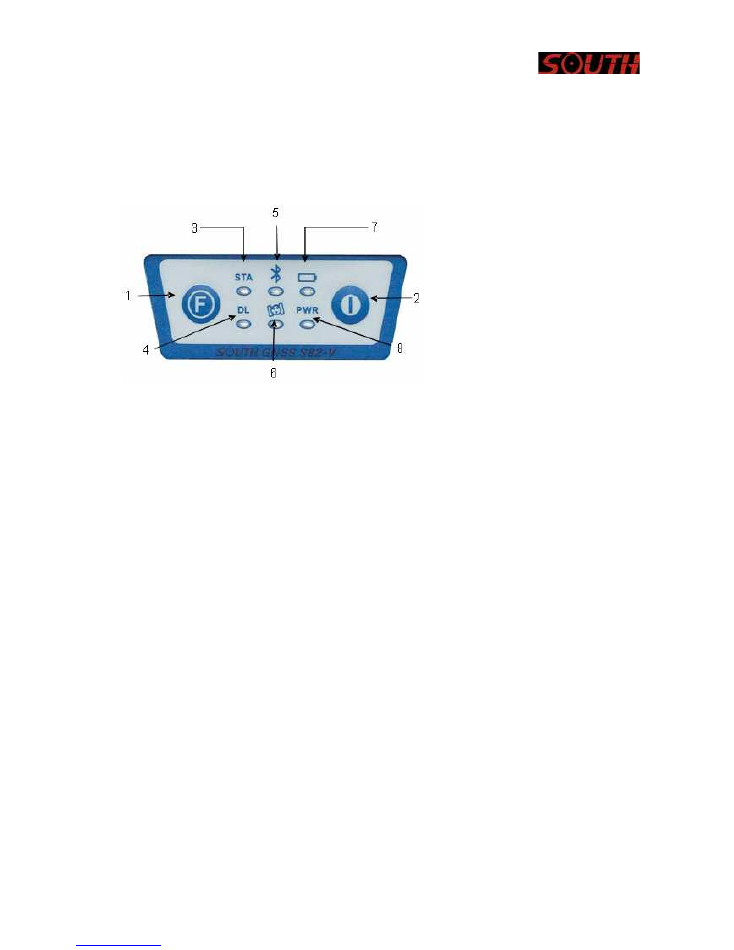
GPS Page 4 of 17 S82V
II.2 Indicator lights and instrument setup
1.
Function Key
2.
Power Key
3.
Status light
4.
Data link light
5.
Bluetooth light
6.
Satellite light
7.
Built-in power supply light
8.
External power supply light
Fig. 2.2
–
S82V keys and indicator lights
As you see by the figure 2.2 there are three sets of indicator LEDs, each with two different
colors and two different functions.
From the left to the right are:
1
st
indicator: status indicator light (red), data link indicator light (green)
2
nd
indicator: Bluetooth indicator light (red), satellite indicator light (green)
3
rd
indicator: Battery power light (red), external power supply indicator light (green).
The descriptions of the LEDs are as follows
BAT
(red)
:
Built-in power supply light (Fig.2.3).
The status of the battery power supply are indicated as follows
1. Fixed: Battery power supply in good condition.
2. Flashing: Battery power supply low.
Usually when the light begins to flash you have one hour of power left.
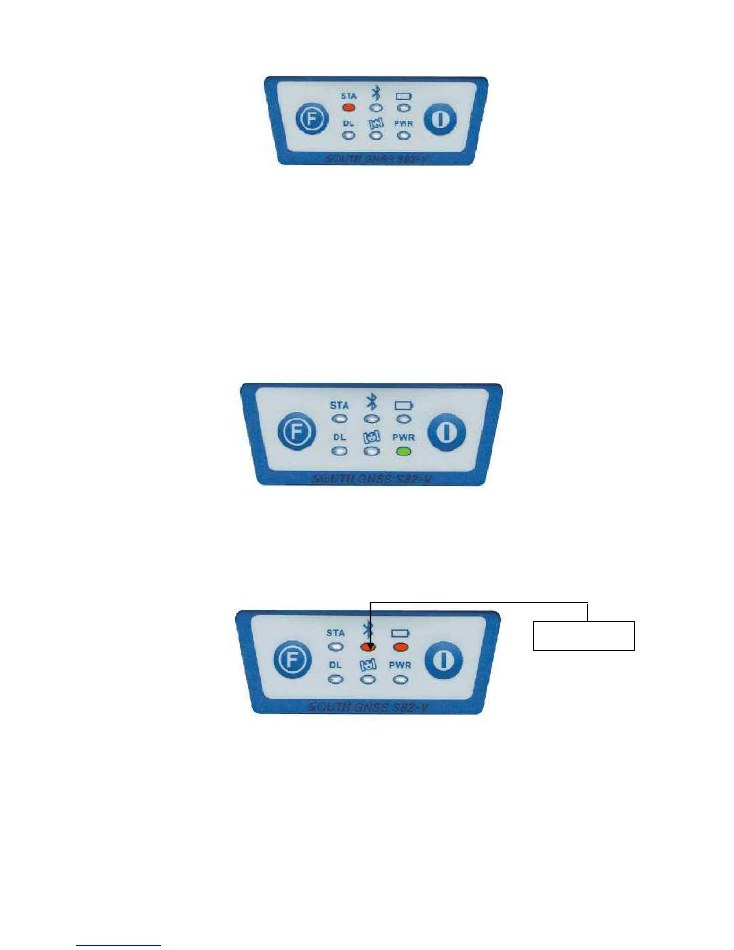
GPS Page 5 of 17 S82V
Fig. 2.3
–
S82V battery power LED
PWR
(green)
:
external power supply light (Fig. 2.4).
The status of the external power supply are indicated as follows
1. Fixed: External power supply in good condition.
2. Flashing: External power supply low
Fig. 2.4
–
S82V external power LED
BT (
red
):
Bluetooth indicator light (Fig. 2.5).
When the controller is connected with the receiver, this light will light up.
Bluetooth light
Fig. 2.5
–
S82V Bluetooth LED
SAT (
green
):
Satellite light (Fig. 2.6).
It shows the amount of located satellites, when the receiver obtains satellites signals, it will
start to blink, the number of blinks corresponds with the number of located satellites.
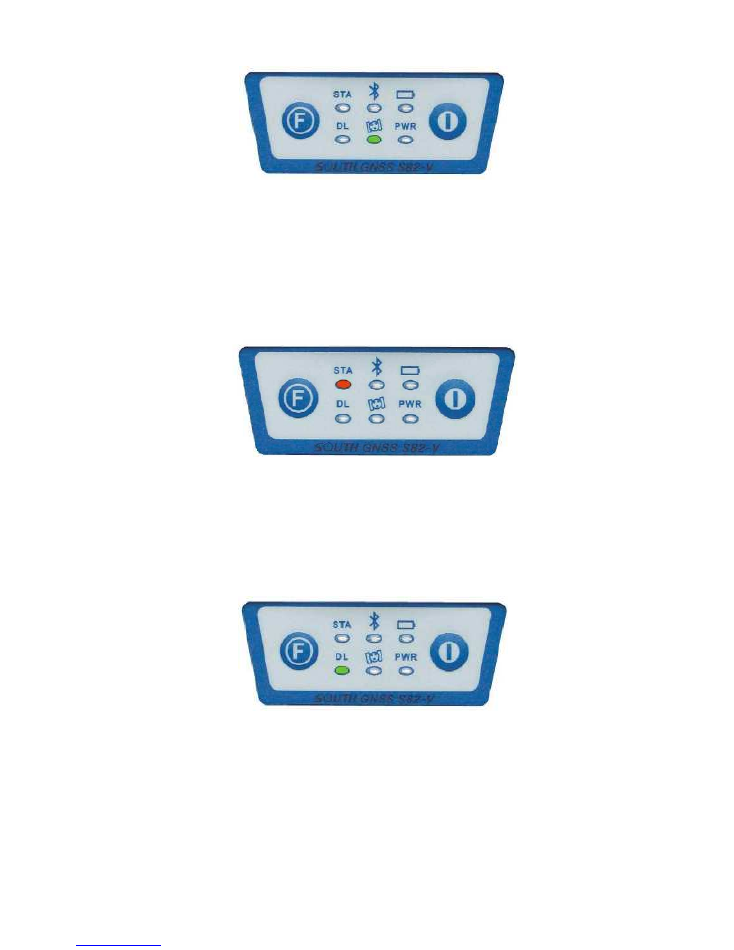
GPS Page 6 of 17 S82V
Fig. 2.6
–
S82V satellite LED
STA (
red
):
Status light (Fig. 2.7).
In static mode, this LED lights when the receiver is recording data. In RTK mode, it shows if the
data link module working in good condition.
Fig. 2.7
–
S82V status LED
DL (
green
):
Data Link light (Fig. 2.8).
In static mode, it will remain lit in normal operation conditions. In RTK mode, it shows if the
data link module working in good condition.
Fig. 2.8
–
S82V Data Link LED
F Key :
Function key
Switches between the working modes (static, base or rover) and RTK communication modes.
P Key:
Power key
Powers unit on/off and confirms selected functions.
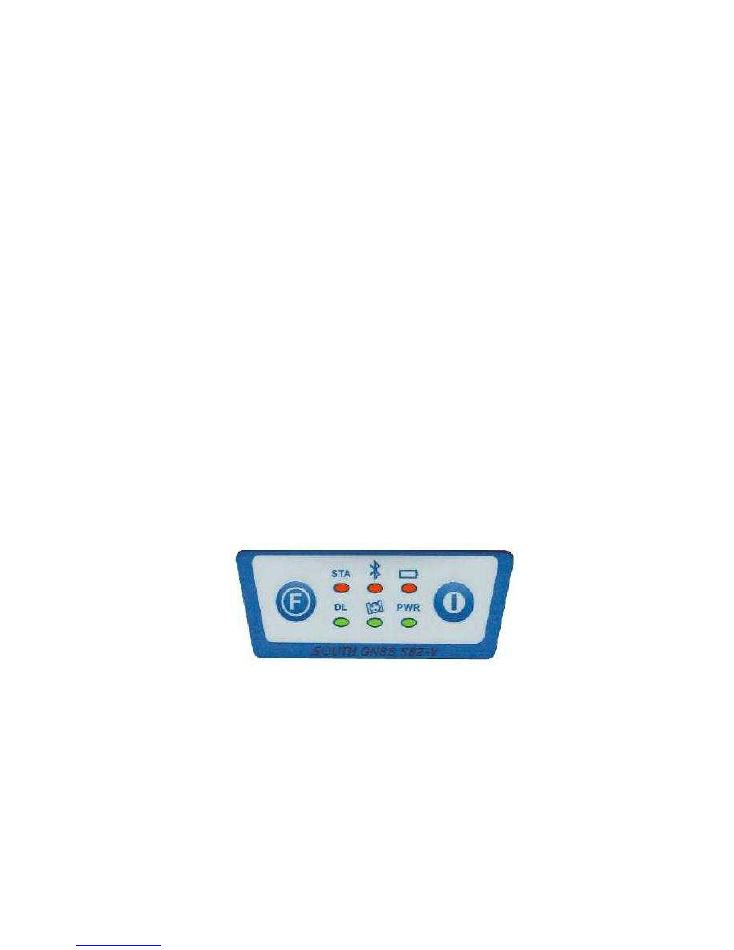
GPS Page 7 of 17 S82V
Power on
receiver: Press P key one time, the receiver will power on.
Power off
receiver: Press and hold P key for few seconds, after three beeps all LEDS will
turn off. At that point release the key, the receiver will power off .
Self-Check:
when the receiver work abnormally, you can make a self-check to
fix it, the
operation procedure is as follows:
- Press and hold P key for more than 10 seconds as for turning it off but keeping pressed
the key after all lights have turned off.
- Release the key when you hear another beep: receiver will start to make a self-check.
The Self-check process lasts typically for about 1 minute, after which receiver will turn on and
resume normal operation.
Selecting the working mode
- With the battery inserted, then press and hold P key + F key: the receiver will start.
- Keep the P key + F key pressed until the six LEDs blink at the same time (Fig. 2.9),
then release the keys.
Fig. 2.9
–
S82V six LEDs blinking simultaneously
- STA LED is lit, now every time the F key is pressed, the working mode will change.
- Press P key when the chosen LED is blinking and the receiver will start the working
mode selected.
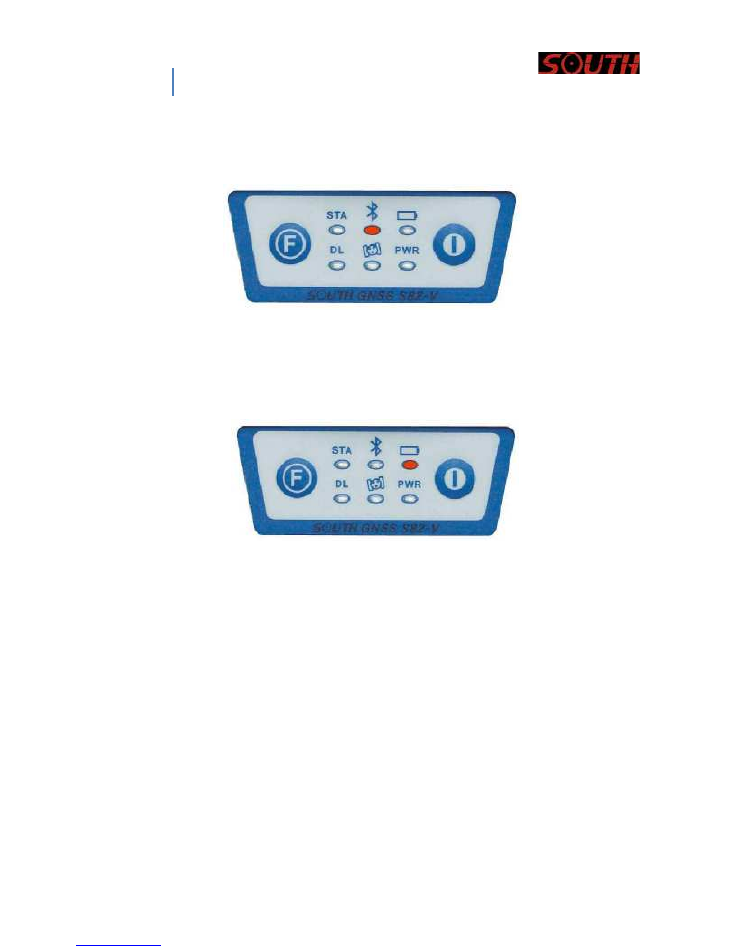
GPS Page 8 of 17 S82V
Chapter II: S82V receiver main unit
Base mode
:
When the BT light blinks, press P key to confirm, you will enter base mode. The
following display shows the receiver in base mode:
Fig. 2.10
–
S82V Bluetooth LED
Static mode
: When the BAT light blinks, press P key to confirm, you will enter static mode. The
following display shows the receiver in static mode:
Fig. 2.11
–
S82V battery power LED
Selecting the communication mode
After you have entered working mode, press and hold F key, when you hear 2 beeps, and see
a green light blinking, release the key, wait several seconds, then press F key, the 3 green
lights will blink in turns. Then you can select the different data link methods through the
different LED choices.
Checking the working mode and communication mode during operation
You can press F key one time to check the work mode and communication mode. There are 6
kinds of status, such as follows.
Static mode
: When you press F key one time and see the following figure, it means static mode.
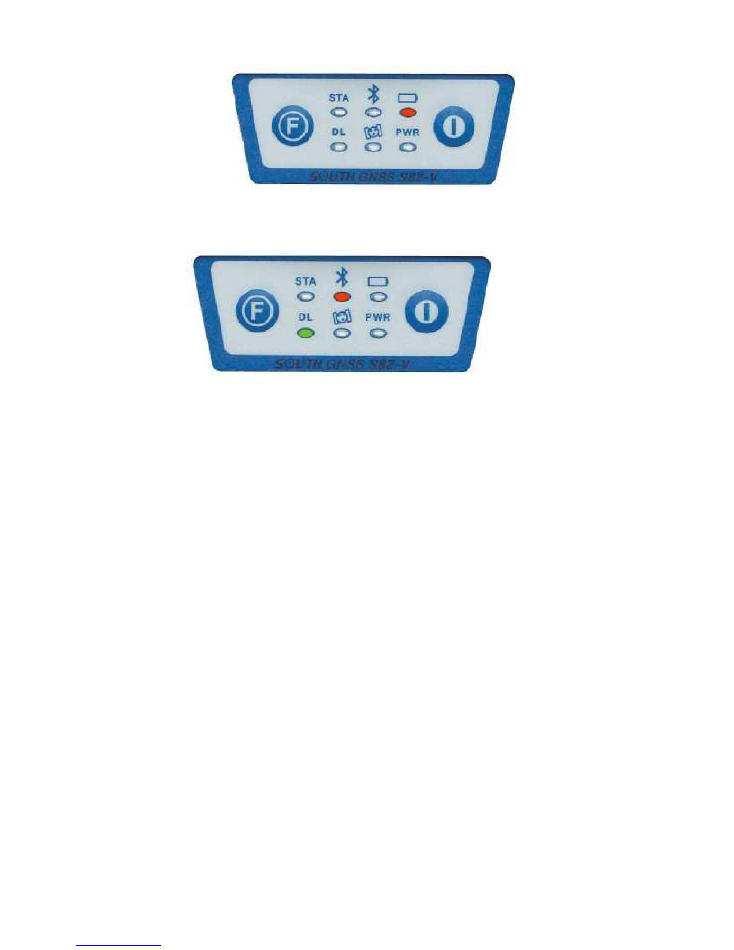
GPS Page 9 of 17 S82V
Fig. 2.12
–
S82V battery power LED
Fig. 2.13
–
Bluetooth and DL LEDs
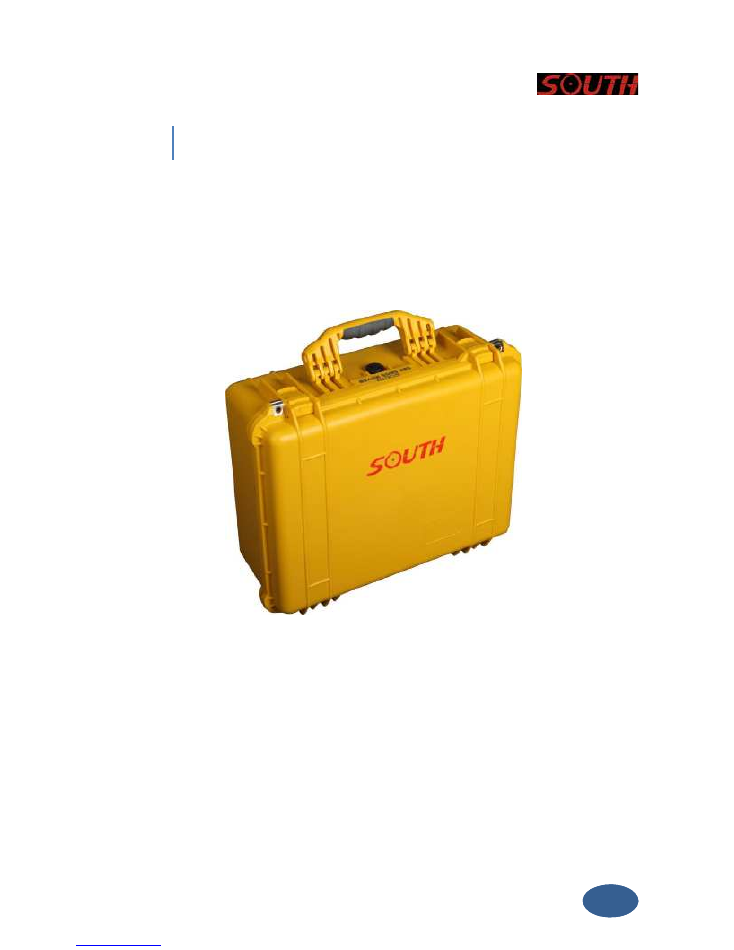
GPS Page 10 of 17 S82V
Chapter IV S82V accessories
Chapter
Ⅲ
: S82V accessories
Ⅲ
.1 The case of S82V
Fig. 3.1 - S82V case
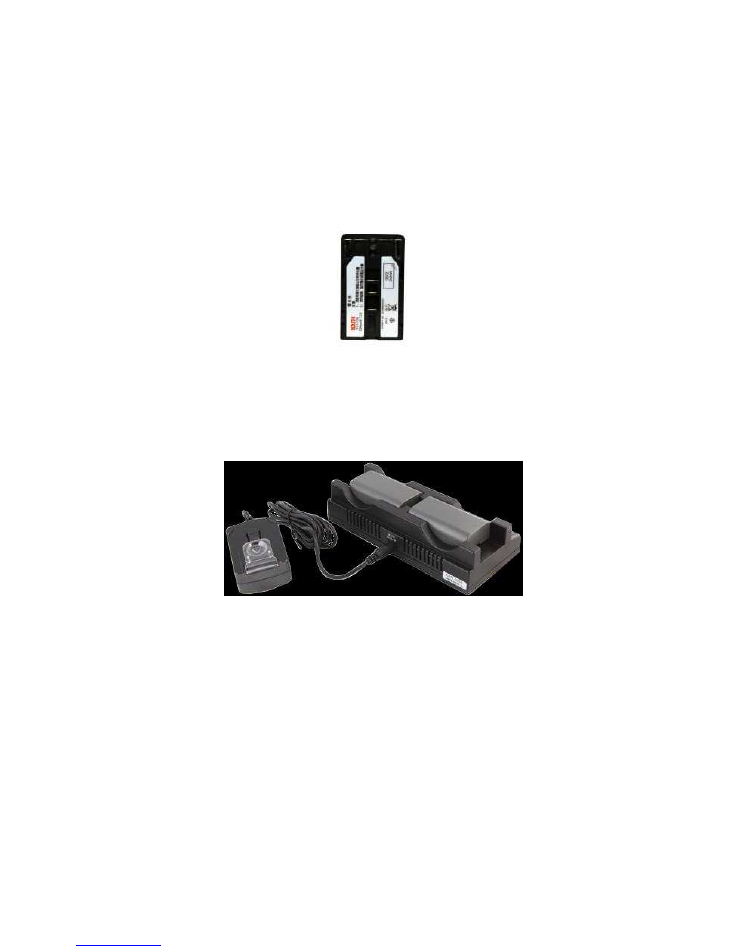
GPS Page 11 of 17 S82V
Ⅲ
.2 Power supply
Receivers
The standard configuration contains two batteries and a slot for charging batteries (named
“
charger
”
for
simplicity)
and
an
adaptor.
The
battery
are
“
lithium
-
ion
”
battery:
a
technology
which has an high energy-to-weight ratio with respect to NiCd or NiMh batteries,
lack of memory effect, and slow self-discharge when not in use.
Fig. 3.2 - Lithium-ion battery
The charger can charge both batteries simultaneously. The lights of the charger shows if a
battery
is
being
charging
or
if
it
’
s
already
charged.
Fig. 3.3 - S82V charger and adaptor
Controllers
The Psion controller standard configuration includes two batteries, a charger and an adaptor.
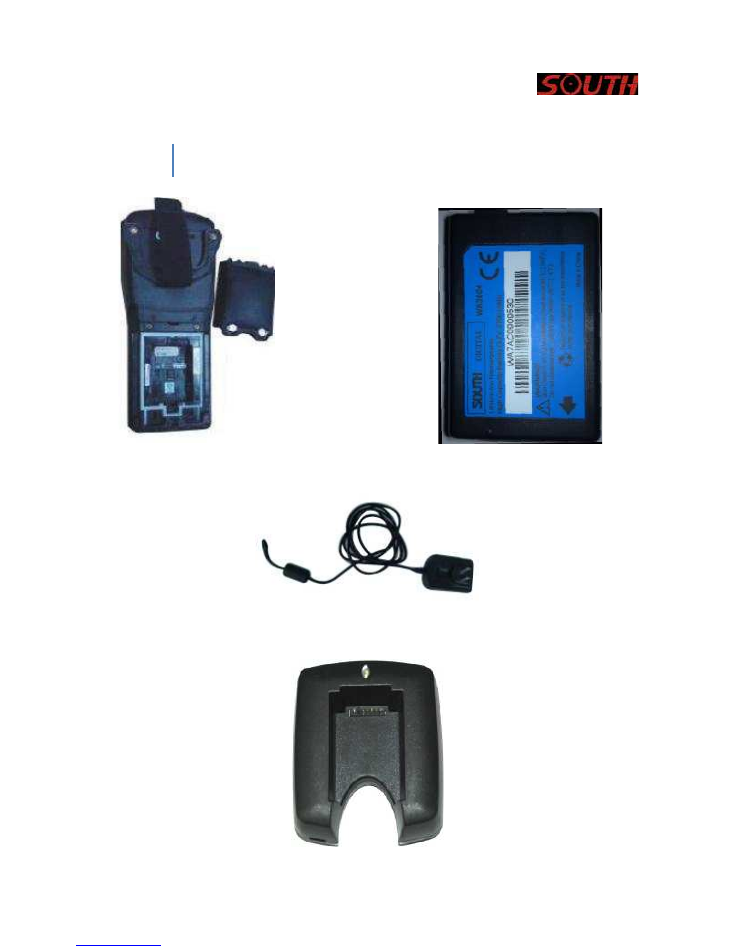
GPS Page 12 of 17 S82V
Chapter IV S82V accessories
Fig. 3.4 - Psion battery
Fig. 3.5 - Psion adaptor
Fig. 3.6 - Psion charger

GPS Page 13 of 17 S82V
Chapter IV S82V accessories
Ⅲ
.3 Cables
Radio cable
External
power
supply
cable
(PCRR)
shape
a
“
Y
”
connection
cable.
It is used to connect the base mainframe (red), transmitting radio (blue) and connect
the accumulator (red and blue clip). It has the function of power supply and data transfer .(Fig 3.7)
Fig. 3.7 - External power supply cable

GPS Page 14 of 17 S82V
Controllers cable
USB communication cable is used for connecting handheld and computer, using the software
Microsoft ActiveSync if you use Windows XP or an earlier version, or Windows Mobile Device
Center if you use Vista or Windows 7 (you can free download these programs from Microsoft
website). There are different cables for different controllers.
Fig. 3.8 - USB communication cable for Psion
Fig. 3.9 - USB communication cable
Receivers cable
Multi-function communication cable: this cable is used for connecting receiver and computer
used for transfer the static data, update of firmware and the license. It can also be used for
connecting GEOS controller and receiver, in case of malfunctioning of the Bluetooth device. See
Fig. 3.10.
Fig. 3.10 - Multi-function communication cable
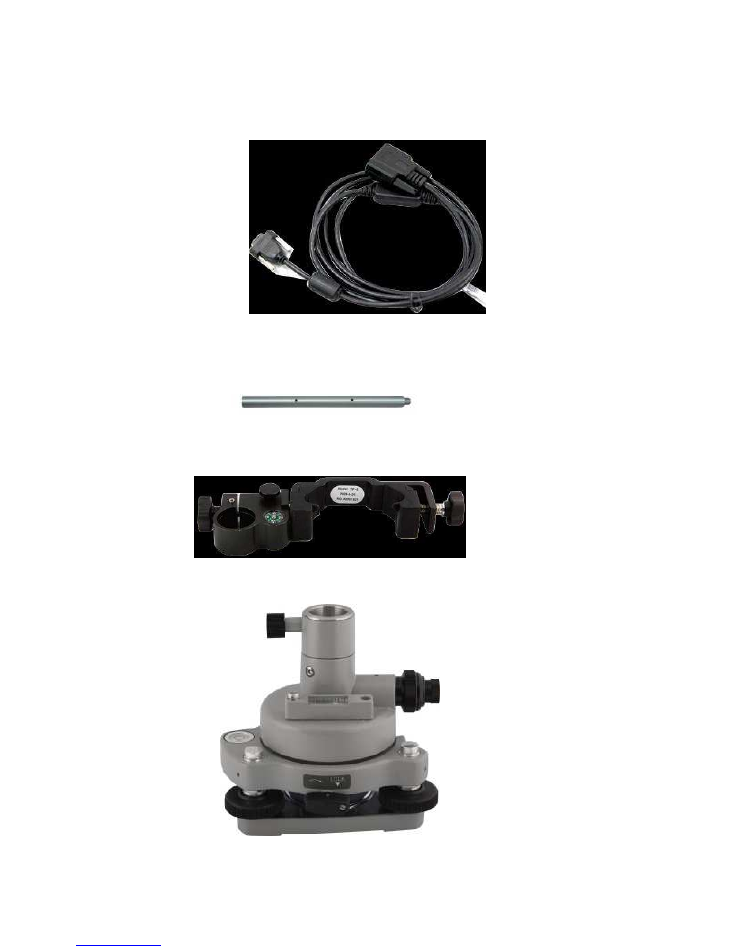
GPS Page 15 of 17 S82V
Inside the Psion bundle there is also a cable used for connecting Psion and receiver, in case of
malfunctioning of Bluetooth device. See Fig. 3.11.
Fig. 3.11 - Communication cable between Psion and receiver
Fig. 3.12
–
30cm supporting pole
Fig. 3.13
–
Bracket for controllers
Fig. 3.14
–
Tribrach and adapter with optical plummet

GPS Page 16 of 17 S82V
Fig. 3.15
–
Connector between tribrach and receiver
Fig. 3.16
–
Measuring tape
On the basis of the configuration chosen (base or rover) some of these accessories are included
or not in the receiver bundle.

GPS Page 17 of 17 S82V
Chapter V: S82V Operations
Appendix 1: Frequently Asked Questions
1. The receiver is set in static mode but it does not save data even if more than three satellites
are locked. The three red lights are blinking.
Solution: the internal memory of receiver is full, please delete some files.
2. The external and built-in power lights are blinking and I do not succeed in
receiving differential corrections.
Solution: The serial code is expired, please contact SOUTH for a new code.
3. I do not succeed in connecting handheld and receiver by Bluetooth.
Solution: you are in static mode and Bluetooth is disabled, please switch mode.
If you are in rover or base mode and Bluetooth still does not work, please perform a receiver
self-check.
If the problem persists please check config.ini, it may be in a wrong format, please contact
SOUTH for a new config.ini file.